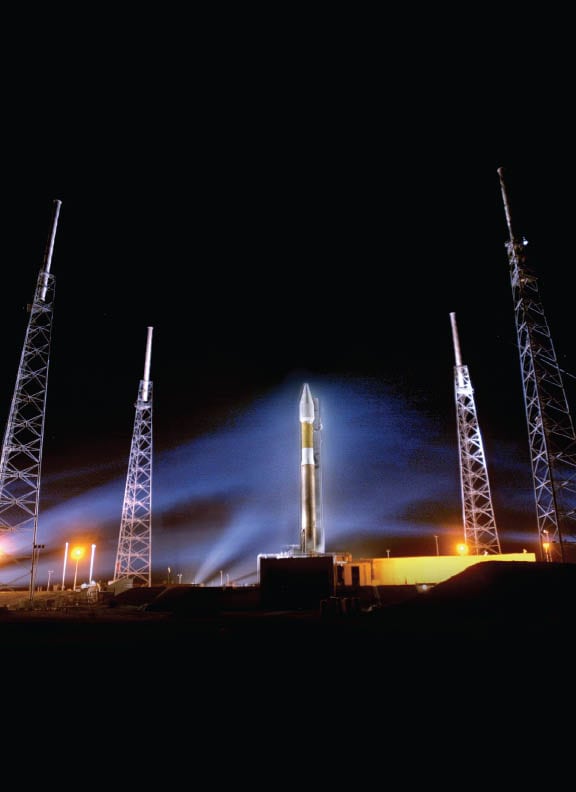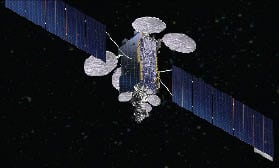Lockheed Martin to Re-Enter the Commercial Satellite Business
Lockheed Martin is an industry giant, and ready to make a splash again in both the commercial satellite manufacturing space, as well as the commercial launch arena. We find out their plans.
Lockheed Martin has a rich heritage in the space industry but in recent years it has concentrated more on its domestic government business rather than being a commercial force around the world. However, with U.S. government budgets shrinking, and opportunities arising in emerging markets, the company is ready for a “coming out” party in the commercial market.
Satellite Bus
Linda Reiners, president, commercial ventures, Lockheed Martin Space Systems, talks about the company needing to “re-invigorate” its commercial satellite communications business. So, what are Lockheed’s ambitions in the manufacturing space in 12 months time? “Two things, you will see that we have been bidding. I think a year from now we should have success with our endeavors. We will also be introducing new products. We will have a new set of products a year from now, and then another set of products a year after that. This is a business that is ripe for innovation,” Reiners says.
It is always exciting when we see one of the industry giants re-engage with the industry. Reiners talks about this being a “transformation” process for the company. “We have got the benefit of this tremendous development effort on the A2100 that we have just completed. We are bringing this platform back into the commercial market in a more robust manner. It will be a different Lockheed Martin Space Systems company going forward. So, a little bit of it is timing. We need to get our price point down. You will know when we reach that point because we will be winning,” she says.
Reiners is charged with leading Lockheed Martin back into the promised land of the commercial satellite communications market. As she talks of a “re-ingivigoration” process, you can’t help but wonder whether things had got a lot of stale for the company in terms of its approach to the commercial market. Reiners denies this and adds, “We have 45 spacecraft on orbit with the A2100 bus. It has turned over 400 years of orbit life. We have 23 in production right now for the military. We have learned a lot about the spacecraft itself, but more importantly things like advanced manufacturing techniques that help drive down costs, and improve the process flow of the spacecraft itself for mistake-proofing. So, making fewer parts, using more common subsystems and components. We have an opportunity to bring so much of that type of innovation as well that I think it is going to give us an advantage from a price, schedule and reliability point of view.”
Lockheed has been through a fairly significant development cycle with the U.S. government with space missions such as navigation, weather, human spaceflight, etc. Reiners admits its attention has been “literally consumed” by the volume of work that they have had, but now the company is in a position where it is able to bring its “latest developments” in spacecraft manufacturing to the commercial market. She calls this a “coming out party” for Lockheed Martin.
The satellite market has fundamentally changed in the last 10 years, with big military satellite communications programs being cut back as the United States, like many other countries, is still going through a time of economic austerity. At the same time, the satellite market is proving vibrant in regions such as Latin America and Asia. This is a fact that Reiners readily admits. She says the company is “excited” about the opportunities in the rest of the world.
“There are emerging companies and national interests that are often every bit as sophisticated as others getting started. Each of those has a very different complexity associated with them. Space is a global venture; there are regions and segments, which means there are opportunities everywhere,” she says.
The satellite manufacturing space is a competitive one with the likes of Boeing, Thales Alenia Space, Astrium and Space Systems Loral contending for not huge amounts of new commercial satellite orders right now. Boeing caused a stir last year when it announced deals with Asia Broadcast Satellite and Satmex for satellites based on electric propulsion. As for Lockheed Martin, Reiners adds, “We are using electric propulsion on our military systems. It is the only electric propulsion system that has achieved transfer orbit using electric propulsion. We are very excited about bringing that to the commercial market. The technology also happens to be higher thrust than our competitors so you will suffer less time in the transfer orbit which I think is a real benefit. You will see increased flexibility and benefits around payloads, the ability of the spacecraft to host dual payloads. A lot of innovation is around our manufacturing process.”
Price will also be an important differentiator for the company. Like the launch division of Lockheed Martin, bringing down price could be key. “It is a buyer’s market in terms of price. That is where our energy has been focused on. I don’t know if my peers have really focused on that, but I think they will be facing that very shortly. They value flexibility as well. A lot of focus has been on that, and a lot of that comes in different flavors. So, that means you have to launch on a variety of vehicles and offer configurations that cover a variety of power levels, so they don’t have to customize for vehicle,” Reiners says. “At Lockheed Martin, we are targeting a very significant investment to drive those costs down and improve the flexibility of the spacecraft and ensure the platform itself meets the range of needs of customers, not just now but where they are going. I am not concerned about our ability to compete.”
Launch Services

The Atlas V rocket operated by the Lockheed Martin-Boeing joint venture United Launch Alliance. Photo: Lockheed Martin
Lockheed Martin also wants to become more of a key player in the commercial launch services business. This is a market with incredibly interesting dynamics right now. Not only there are established players such as Arianespace and ILS, but there is also Sea Launch, which is trying to re-invent itself, and SpaceX, a company that has the potential to shake-up the launch industry.
The man in charge of leading Lockheed Martin’s re-emergence in the commercial launch market is Robert Cleave, president, Lockheed Martin Commercial Launch Services. One of the biggest perceptions he will have to overcome is a price perception issue. The company is seen as expensive, and while some would argue the cost of a successful launch is priceless, it is clear Lockheed Martin will have to adapt its approach.
“Price point is a function of rate. If you don’t have the rate, you can’t have the price point. The question is who is your anchor tenant? Every launch provider, including Atlas has an anchor tenant. There is no rocket out there which will survive without an anchor tenant,” Cleave says. “If you look at Atlas, the U.S. government recently committed to a block buy of Atlas and Delta launches. The shareholders upped the ante and we ended up with a very low cost basis. You have to have the rocket science, the quality control and then the price point.”
The big question is how much can Lockheed Martin bring down the cost of its launch services. Ultimately, this could determine its success in the market. Cleave says the company’s supplier, ULA, has done a “terrific job” not only in terms of mission success but consolidating the operations of two product lines – the Delta and the Atlas. “They have also been able to take advantage of the purchasing power that was given to them by the shareholders and the U.S. government to give us a substantial reduction in our price points,” he adds. “So, yes, it is over 30 percent less in terms of price point compared to two or three years ago. We will never be as inexpensive as a Proton. We could not have gone into the market at the price point we had two years ago. I think we are able to go in and compete.”
Like Reiners, Cleave is focused on doing new deals in the commercial sector. In September, the company announced has it had been selected by the Secretaria de Comunicaciones y Transportes, a government agency of Mexico, to provide commercial launch services using the Atlas 5 launch vehicle for Mexico’s Morelos 3 communications satellite (also known as Mexsat 2). The launch is scheduled to occur as early as 2015 from Cape Canaveral. Morelos 3 will be the third of three communications satellites that comprise the Mexsat communications satellite system. Mexsat is a constellation of satellites owned by the Secretaria de Comunicaciones y Transportes and operated by Telecomunicaciones de Mexico that delivers advanced telecommunications throughout Mexico.
Doing a deal with one of the “Big Four” among FSS operators (Intelsat, SES, Eutelsat and Telesat) could be on the horizon, Cleave says. “When we look at markets around the globe, the likes of SES, Intelsat, Eutelsat, and Telesat control a substantial fraction of the market. Those companies have always wanted to use Atlas; their capital expenditure cycles is pretty well fixed in the near term, particularly when one looks at Intelsat. Will they be changing their plans in the next few months? It is hard to say,” he says. “It may take time to make breakthroughs with the ‘Big Four.’ In 2013, we hope to get another deal. In the next 12 months, we are targeting one or two deals a year.”
If Lockheed Martin were able to close a deal with these companies, it would be a real statement of intent. “Some operators have said ‘we are fully booked for a while,’ but at least one has said they have interest. So, I would say within the next six months,” Cleave says. “Atlas is a shared asset between the U.S. government and us, so, we have to maintain that. The Atlas vehicle will become increasingly available in 2016 as ULA peaks in launches with the U.S. government over the next two years or so.”
Lockheed Martin sees one competitor as standing out. “We see Arianespace as our major competitor, and we have several key discriminators,” Cleave says. “For example, Ariane 6 has no rideshare. In terms of reliability, we believe we have an edge.” Considering that Arianespace is perhaps their only competitor, one or two deals per year could be perceived as conservative. “My father taught me something very valuable when I first got in the business, which is that your career is a marathon and not a sprint,” says Cleave. “The minute one starts cutting corners is when one gets into trouble. So, yes I do think there is an upside business case. But, there is also a downside business case if we are not careful.” VS
